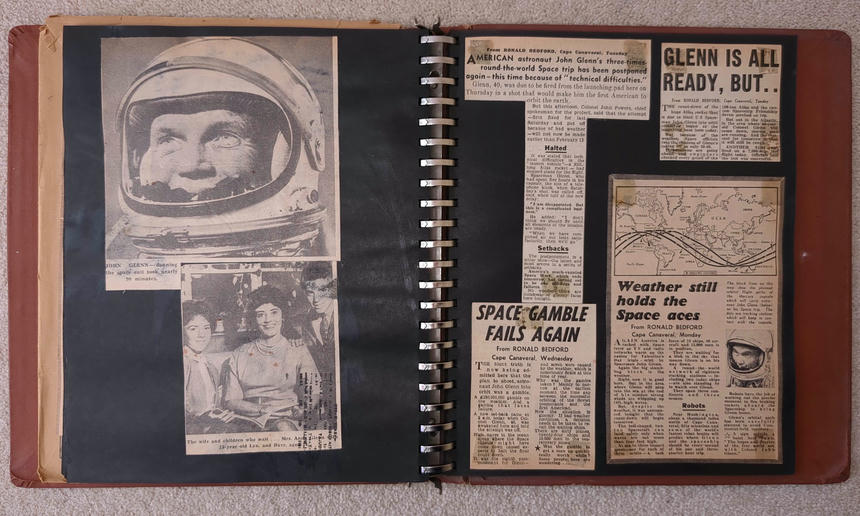Scrapbook 1: Jan 1962 — John Glenn

JOHN GLENN—donning the space suit took nearly 90 minutes.
The wife and children who wait . . . Mrs. Anna Glenn with 13-year-old Lyn, and Dave, age[…]
From RONALD BEDFORD, Cape Canaveral, Tuesday
AMERICAN astronaut John Glenn’s three-times-round-the-world Space trip has been postponed again—this time because of “technical difficulties.”
Glenn, 40, was due to be fired from the launching pad here on Thursday in a shot that would make him the first American to orbit the earth.
But this afternoon, Colonel John Powers, chief spokesman for the project, said that the attempt—first fixed for last Saturday and put off because of bad weather—will not now be made earller than February 13.
Halted
It was stated that technical difficulties in the “launch vehicle”—a 93ft.-long Atlas rocket—had stopped plans for the flight.
Spaceman Glenn, who had spent five hours in his capsule, the size of a telephone kiosk, when Saturday’s shot was called off, said, when told of the new delay:
“I am disappointed. But this is a complicated business.”
He added: “I don’t think we should fly until all elements of the mission are ready.
“When we have completed all our tests satisfactorily, then we’ll go.”
Setbacks
The postponement is a bitter blow—the latest and most severe in a series of setbacks.
America’s much-vaunted Space Week, which ends tomorrow, has turned out to be one of flops and failures.
No wonder there are hundreds of gloomy faces here tonight.
GLENN IS ALL READY, BUT..
From RONALD BEDFORD, Cape Canaveral, Tuesday
THE count-down of the huge Atlas rocket that is due to blast US Spaceman John Glenn into orbit tomorrow began at the launching base here today.
But, because of the weather, Space officials rate the chances of Glenn’s taking off as only 50-50.
Preparations are going ahead, and engineers checked every detail of the 100-ton Atlas and the two-ton Spaceship Friendship Seven perched on top.
But out in the Atlantic, in the area where 40-year-old Colonel Glenn will come down, stormy seas are running. And the forecast for tomorrow is that it will still be rough.
ANOTHER Atlas was fired on a 7,000-mile test flight today. Officials said the test was successful.
SPACE GAMBLE FAILS AGAIN
From RONALD BEDFORD Cape Canaveral, Wednesday
THE blunt truth is now being admitted here that the plan to shoot astronaut John Glenn into orbit was a gamble.
A £150,000,000 gamble on the weather. And a gamble that faces failure.
A new set-back came at 2 a.m. today when Colonel Glenn, 40, was awakened here and told the attempt was off.
High waves in the ocean areas where the Space capsule might have come down caused experts to halt the final count down.
It was the eighth postponement for Glenn—and seven were caused by the weather, which is notoriously fickle at this time of year.
Why was the gamble taken? Mainly to narrow at the earliest moment the time gap between the successful orbiting of the Soviet cosmonauts and the first American.
Now the situation is gloomy. If bad weather continues, a decision needs to be taken to recall the waiting ships.
There are sixty planes, twenty-four ships and 15,000 men in the sea-recovery zones.
- Was the gamble to get a man up quickly really worth while? Some people here are wondering. . . .
Weather still holds the Space aces
From RONALD BEDFORD Cape Canaveral, Monday
AGAIN America is racked with Space fever as TV and radio networks warm up the nation for Valentine’s Day triple-orbit by Spaceman John Glenn.
Again the big stumbling block is the weather.
Right now it is good here. But in the area where Glenn will plop into the sea at the end of his mission strong winds are whipping up 10ft.-high waves.
But, despite the weather, it was announced tonight that the count-down will begin tomorrow.
The bell-shaped, two-ton Spacecraft can land safely only when waves are not more than four feet high.
At sea in three impact zones—one for each of three orbits—a task force of 24 ships, 60 aircraft and 15,000 men Is in position.
They are waiting for a blob in the sky that means Glenn is on his way down.
A round-the-world network of eighteen tracking stations—including two radar ships—are also standing by to watch over Glenn.
They span three continents and three oceans.
Robots
Near Washington, about a thousand miles north of Cape Canaveral, fifty scientists and some of the world’s fastest robot brains will predict where Glenn and the spaceship should be every second of his one and three-quarter hour trip. Robots have the job of working out the precise moment to fire braking rockets aboard the Spaceship to bring Glenn home.
Glenn’s orbital path has been carefully planned to avoid Communist-held territory.
- A sign outside a hotel here says: “The hopes and prayers of the free world are with Colonel John Glenn.”
The black lines on this map show the planned orbital flight paths of the Mercury capsule which will carry astronaut John Glenn (below) on his Space trip. The dots are tracking stations which will keep in contact with the capsule.